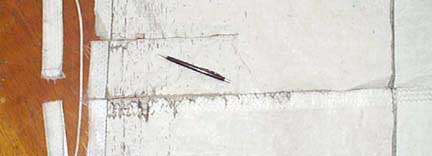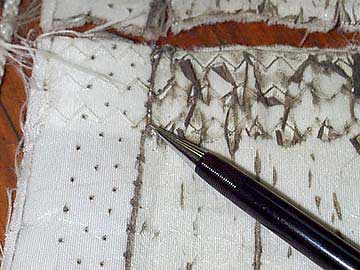The Problem With Inexpensive
UV
Covers for Roller Furling Jibs
September 1997

We have just had a customer bring in a four and a half year old furling jib, made by some other sailmaker,
which "needed the leech fixed up a bit." Unfortunately we were not able to revive the patient.
The sail was a dacron jib with a tedlar film for the UV
border. One sailmaking catalog describes this material as "flexible, highly sun-protective tedlar film with pressure
sensitive adhesive for
roller furling sails." Although the tedlar film itself costs about the same as Sunbrella (or Acrilan), it can be installed
on the sail in much less time because it is simply glued on rather than sewn down. In today's price sensitive world, this
means the jib costs less money...sort of.

This photo gives
an overview of the leech, showing the width of the cover,
and two typical failures. One is immediately above a seam (see also the photo above), and another tear
which is not related to a seam. With one exception, all the photos are of this particular seam in this
sail. However, in other locations, there were four more failures just above a seam, just like this one
(although smaller), and two non-seam failures, and, as one photo below shows, several areas which are threatening
to fail.
The problems here are as follows:
- The tedlar film is not protecting the structural sail cloth.

- In areas where the film is not bonded directly to the sail cloth, the film is failing. These areas
are primarily (1) on top of the stitching in the seams, and (2) spanning the vertical height from one
piece of sailcloth down to the next, which is immediately at the top of the seams in these
pictures.
- Even in areas where the film is bonded directly to the sailcloth, you can see that it is blistering
away, leaving the dacron unprotected.
- The order in which the pieces of the sail are put together has caused a problem at the leech of this
sail:
- The sail was seamed.
- The tedlar border was glued on.
- A UV treated dacron tape was sewn on the leech to hold the leech
cord.
- Notice that the film is in much better condition where it has been protected from the sunlight by
the leech tape.
- Also notice that the UV treated dacron leech tape is failing, and when it breaks the sail itself
will tear. There were MANY flaws in the leech
tape like this one. (See photo below.)
- [This is the order Pineapple Sails uses for building roller furling jibs:
- [The sail is seamed.
- [The leech cord is sewn into a hem running down the leech of the sail.
- [The Sunbrella UV border is put on last, and wraps completely around the leech, covering the entire
back edge of the sail.
- How do you catch the problem in time?
- One of the dangers of roller furling jibs is that you don't get down on your hands and knees and
fold the sail. When you fold a sail you actually touch the sailcloth, and your eyes are only two feet
away from the sail...These kinds of problems are a lot easier to see up close, as the photographs
show!
- At the end of every season you should probably take your sails into your sailmaker and ask them
to go over the sails. In fact it would be best of all if they could go over your sails while you are
there (a phone call for an appointment would be appreciated!), so you could listen and learn from their
observations. And speaking of 'end of the season,' you might
want to read the article on how to destroy a roller
furling jib without even going sailing!

This photo show
an area of coming weakness. Notice that in the leech tape there is a hole, and in the body of the sail straight
in from the hole there is a localized area of wrinkles which is the beginning of a failure which would have
turned into a tear if left unchecked.
Are these tedlar films completely unacceptable? No. There are circumstances where they are good. If you
have a relatively light sail, say five ounce or less, then the weight of the acrylic hangs pretty heavy
on the leech, so something like tedlar might be okay. (The sail in these photographs is a 7.5 ounce 135%
genoa from a 44 footer!) We happen to prefer using light UV treated dacron sewn on top of the structural
dacron, because when the time comes to replace the cover cloth, we can remove the old deteriorated cloth
and put on a new layer. Another case is if you are racing your boat, and you feel the sail will be too
slow to be competitive within four or
five years, then who cares?
There are other circumstances however which make things more difficult. In the case of this boat, the
current owner bought the boat used about a year and a half ago. He had no idea there was anything going
wrong with the jib. I can speculate that the previous owner, who bought the boat from a dealer, also did
not know the short lifetime he was buying into. If you are buying a new boat, you may want to at least
inquire as to the material used for the UV cover on the jib. One of the things to keep in mind is that
the cover on the jib has the same job as the sail cover on the mainsail. What type of material is being
used there?
For durability, there is nothing currently available which has a better track record at UV protection
than Sunbrella. We are regularly re-stitching Sunbrella borders to sails which are 8 to 10 and even 12
years old. I would go so far as to say if you have a non-acrylic border on a roller jib, you need to see
it just like you see bottom paint: after a certain length of
time it must be replaced!
So, here comes the sales (sails!) pitch: high quality sails made from high quality materials are worth
the price. There is a difference, and
they will cost less in the end. |




